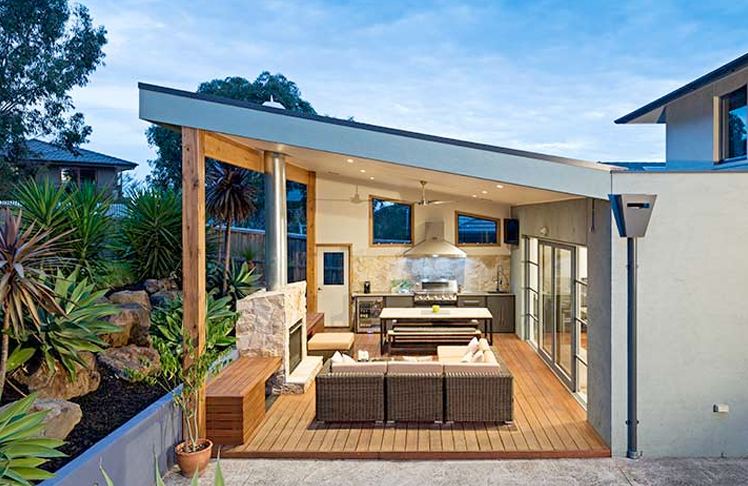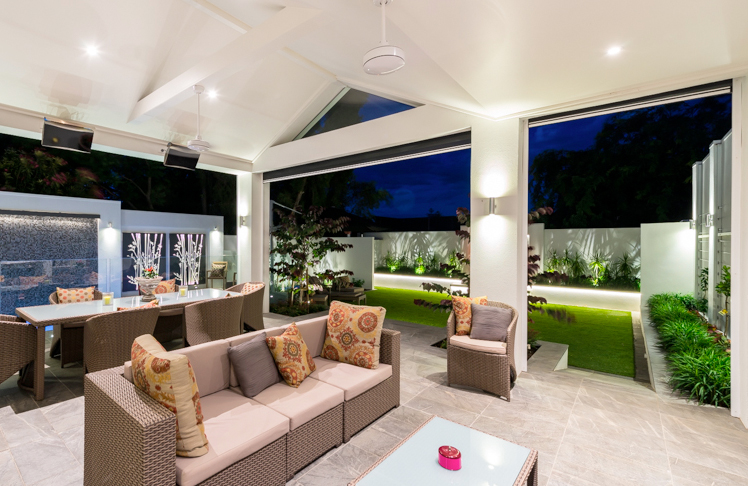Outdoor living and entertaining is part of the Australian way of life. The climate in most parts of the country is ideal for being outside, and it is part of our culture to entertain family and friends in the great outdoors. In your new house design, it is about bringing the outside world in, and extending living spaces past the back door. Here are our top tips for designing the best outdoor alfresco living area:
1.Integrate inside and outside
Ideally you want to design your alfresco room to feel as integrated and connected to the indoor living spaces as possible.
- The doors you choose can affect the flow between your inside and outside spaces. Large sliding, folding or concertina glass doors that push back or fully retract, will decrease the barriers between the spaces and open up the house to the outside.
- Having the inside and outside floor heights the same will make it feel like your alfresco area is an extension on your internal living space
2. Size
Think about how you are going to use the space to determine the best size.
- For entertaining it will need to be large enough to fit a table and chairs (min. 3 x 4m). If you have an outdoor kitchen or BBQ you will need a little more space between the cooking and sitting areas.
- For a casual outdoor lounge space you might have 1-2 outdoor lounges, a chair to relax in with a good book and a low table for drinks (min. 3x4m)
- A multi-functional room with both casual lounge and entertaining (min. 3x5m)
3. Shade
Your alfresco room should be a space you can enjoy throughout the day. In the Australian climate it is particularly important that there is adequate shade cover. For alfresco areas that are integrated with the main house, they often have a fully plasterboard ceiling, but if not, here are a few ideas.
- Plant a deciduous vine or creeper to grow over a pergola or screen
- Use timber battening to extend an awning
- Think about trees that you could plant to provide shade in the hot summer months
4. Climate/weather
It is great if you can use the space all year around and in most weather conditions.
- Retractable clear awnings or shutters can protect from rain and wind
- In the colder climates of Australia you can consider including features such as fireplaces
- In warmer climates it is advisable to include ceiling fans.
5. Outdoor kitchens/BBQ
If you are thinking about including an outdoor kitchen, here are some questions to ask yourself:
- You need to think about how you will use this space. Will you still use your main kitchen for prep and then cook outside? Or do you want to be able to do everything outside? This will affect your choice of appliances, whether you need a sink and how much bench space you will need.
- It needs to be suitable for exposure to the elements
- Select surfaces that are easy to clean and maintain
6. Lighting
Lighting is a really important element that can help set the tone of your alfresco area. Unlike some of your indoor spaces where you need bright task lighting, this is an area where you want to create a relaxed atmosphere. Have multiple lighting options.
- Dimmable LED down lights could be used while you are preparing food
- Up/down wall lighting is perfect for creating a relaxed ambience.
- Spotlights can be directed on to the garden to highlight the surrounding environment.
7. Decorating/Styling
With all the choices you make in styling your outdoor room, you want to think about creating a relaxing calm mood.
- Try a darker shade of paint than you’ve used inside
- Experiment with natural materials and textures to blend the inside and out (eg. stone, timber, renders)
- Furniture should be able to withstand the weather, but also convey a more relaxed style that you might have inside.
8. Landscaping
Just as you should think about how your inside spaces blend with your outside spaces, don’t forget to consider what kind of landscaping you are likely to do. The best alfresco areas seamlessly link between both spaces and should integrate with your landscaping.
- Think about including greenery in pots or having a green wall within your alfresco area
- Have stepping stones or paving directing people from your alfresco outdoor room to the garden
- Consider using similar materials in both areas (eg. bricks, stones, timber accents)







